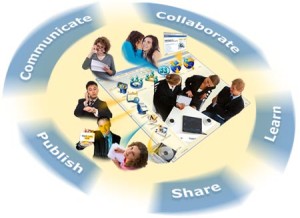Great Things Happen When People Collaborate
 I’m not sure whether you have noticed the number of discussions, articles, webinars and postings around the whole concept of collaborating. Obviously, there is a lot of value in being able to do just that and it comes out in a number of different ways. One of the ways that we see collaboration working a lot is through the creation of something. That something could be a project, a PowerPoint, a new product, sales training, a new piece of collateral, etc., that multiple people or departments need to collectively work on in order to create the best outcome.
I’m not sure whether you have noticed the number of discussions, articles, webinars and postings around the whole concept of collaborating. Obviously, there is a lot of value in being able to do just that and it comes out in a number of different ways. One of the ways that we see collaboration working a lot is through the creation of something. That something could be a project, a PowerPoint, a new product, sales training, a new piece of collateral, etc., that multiple people or departments need to collectively work on in order to create the best outcome.
It’s interesting that even though we know that we are not a silo unto ourselves and that we all can benefit from the input and contribution of others, we often see departments doing just that, becoming a silo. There have been a number of books written about how departmental silos inhibit a winning culture within an organization.
Especially in the area of Sales Enablement, one of the key components that people are talking about is how collaboration is a very important way for organizations to capitalize on the tribal knowledge and experiences of people within the organization that aren’t limited to being just in sales. It’s amazing how valuable that people in customer support or technical support who are actually interfacing with the customer on an ongoing basis, can make a huge contribution to the knowledge of the marketplace. Unfortunately, many organizations don’t have a structured or formal way for those people to contribute and collaborate like they should, so often times the right hand doesn’t know what the left hand is doing.
I love the image above because it represents what a healthy, homogenous organization looks like. When people are given the opportunity to contribute and share their knowledge and experiences with others, then great things happen within those organizations. The more open departments and people are to sharing information and knowledge, the greater and efficient the organization will be. Those organizations that develop a structured way in which people can collaborate and work together can then capture and share that knowledge with others in the future.
Another very import aspect of collaborating is that it provides feedback loops so that others involved in the collaborative experience can benefit from. For example, Marketing often is thrown under the bus for creating sales messaging, content and collateral that doesn’t resonate with the people it was designed for. So, if Marketing doesn’t have a way for those people who are responsible for using it to give feedback on the quality and value of that content and collateral, then they are destined to either use it like it is and suffer the consequences or try and edit it to make it better. Neither of those options are favorable. Unfortunately, we have seen statistics where sales people spend as much as 25% of their time rewriting content that Marketing has provided. This is not only a waste of valuable sales time, but it also adds to inconsistency in what is being delivered. So, if there is a way for Sales to collaborate and give feedback to Marketing on the quality and value of what they are being provided, then it will add to greater Sales and Marketing alignment and better quality content.
I don’t mean to pick on Marketing here, as the above was simply an example that we see all too often. The truth is that a large number of new product launches fail and again that can be tied to the fact that Product Development departments will often develop products without getting the proper collaboration and feedback from others outside of their departments. The results are they often wind up missing their target with regards to providing the right products for the right markets.
Bottom line, whether you are working in a small or large organization, the need to collaborate and share information, knowledge and experiences can only lead to greater things. If you or your organization aren’t doing it, then you really need to start.
At least that’s the way I see it, what say you?

